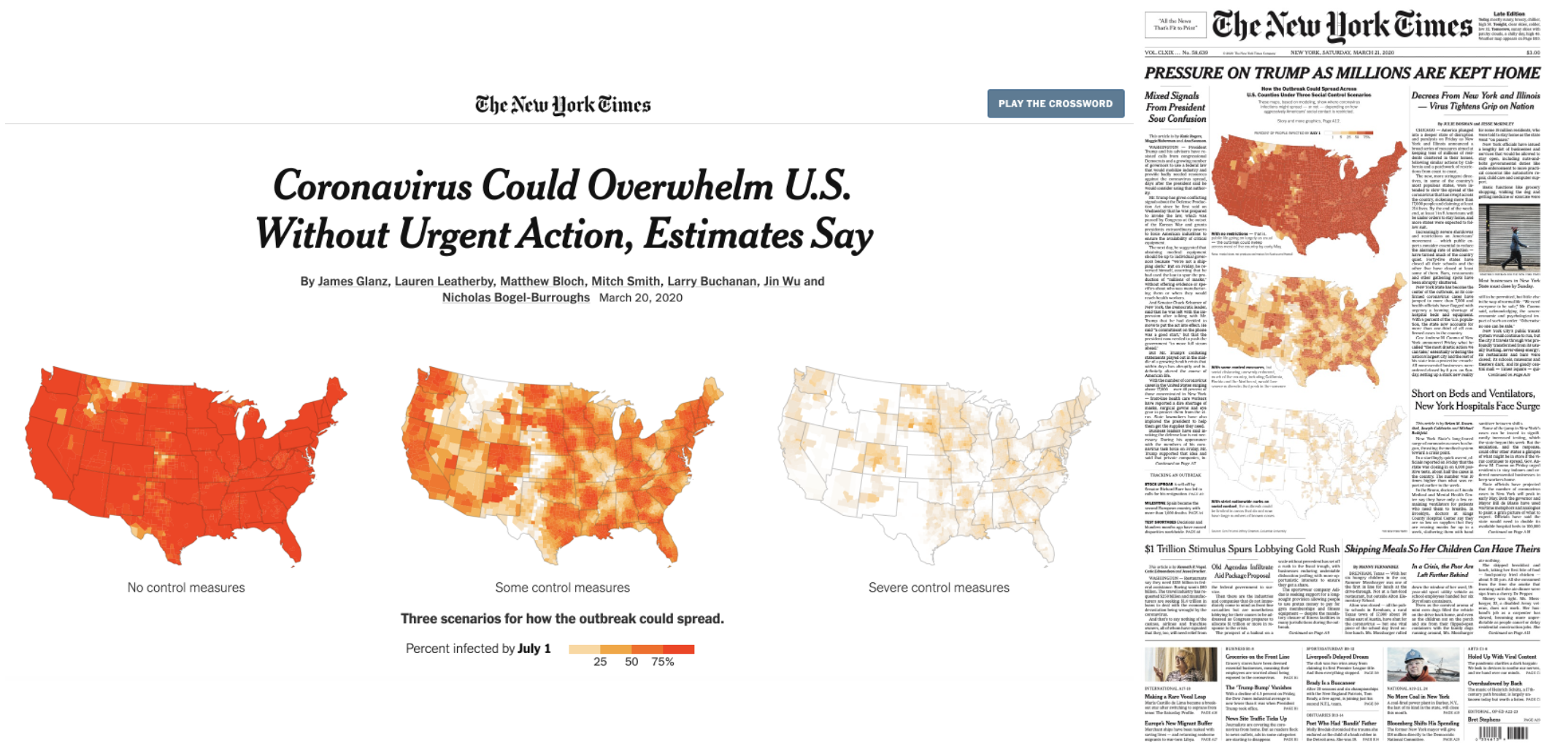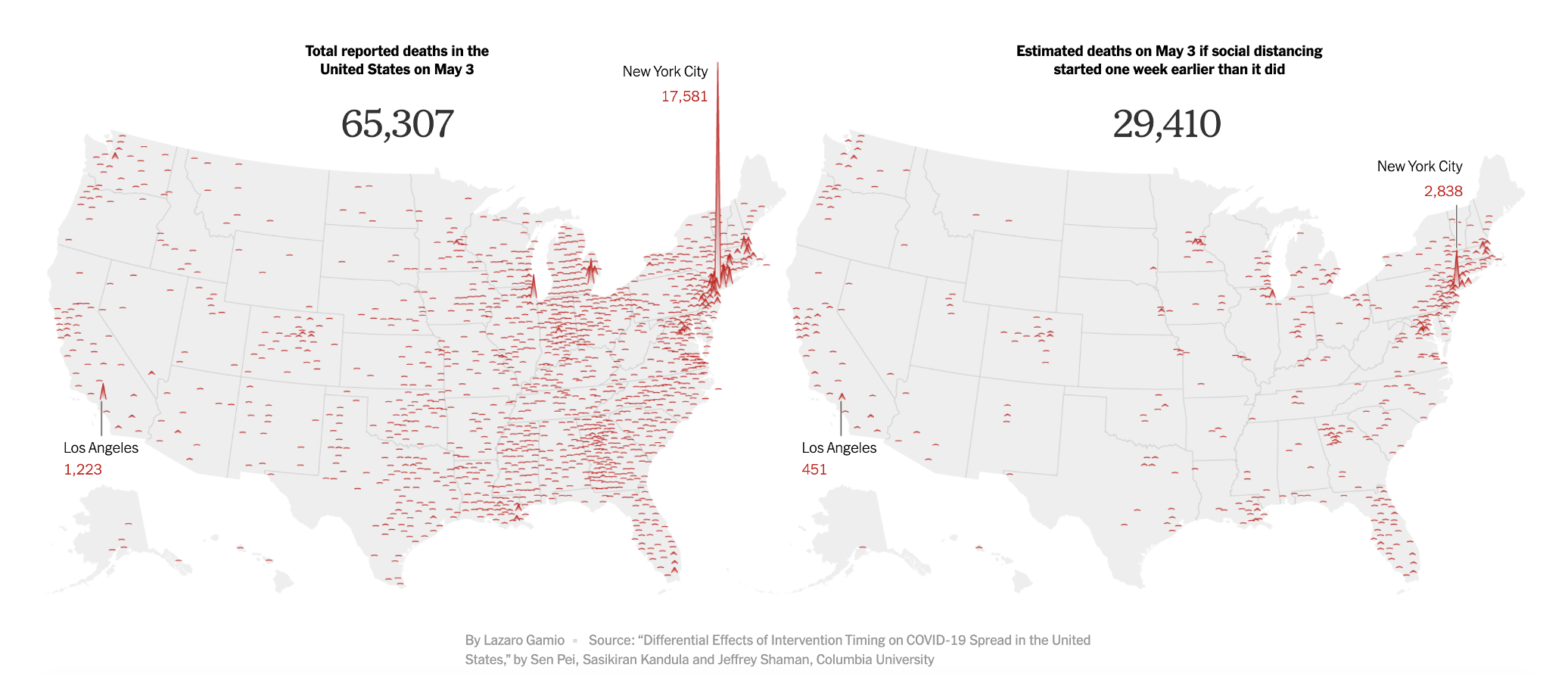COVID-19

In response to the global outbreak of SARS-CoV-2, we have conducted several modeling studies to address important and urgent questions in understanding the transmission of SARS-CoV-2.
Projecting COVID-19 spread in the United States
We developed one of the first COVID-19 projections for 3142 US counties in March 2020. From March 2020 to March 2023, we produced real-time COVID-19 forecasts for US counties updated weekly. These forecasts were made available to the public and were submitted to the CDC COVID-19 forecast hub. Our early simulation of COVID-19 spread in the US was covered by the New York Times “Coronavirus Could Overwhelm U.S. Without Urgent Action, Estimates Say”, which was featured on the front page of the New York Times on March 21, 2020.

Undocumented infection fuels rapid spread of SARS-CoV-2 in China
Estimation of the prevalence and contagiousness of undocumented novel coronavirus (SARS-CoV-2) infections is critical for understanding the overall prevalence and pandemic potential of this disease. Using observations of reported infection within China, in conjunction with mobility data, a networked dynamic metapopulation model and Bayesian inference, we inferred critical epidemiological characteristics associated with SARS-CoV-2, including the fraction of undocumented infections and their contagiousness. We estimated 86% of all infections were undocumented (95% CI: [82%-90%]) prior to January 23, 2020 travel restrictions. Per person, these undocumented infections were 55% as contagious as documented infections ([46%-62%]) and were the source of infection for two-thirds of documented cases. These findings explain the rapid geographic spread of SARS-CoV-2 and indicate containment of this virus will be particularly challenging. See the research article published in Science.
Counterfactual simulations of COVID-19 spread in the United States
Assessing the effects of early non-pharmaceutical interventions on COVID-19 spread is crucial for understanding and planning future control measures to combat the pandemic. We used observations of reported infections and deaths, human mobility data, and a metapopulation transmission model to quantify changes in disease transmission rates in US counties from March 15 to May 3, 2020. We found that marked, asynchronous reductions of the basic reproductive number occurred throughout the US in association with social distancing and other control measures. Counterfactual simulations indicate that, had these same measures been implemented 1-2 weeks earlier, substantial cases and deaths could have been averted, and that delayed responses to future increased incidence will facilitate a stronger rebound of infections and death. This study, published in Science Advances, was reported by the New York Times “Lockdown Delays Cost at Least 36,000 Lives, Data Show”.

Burden and characteristics of COVID-19 in the United States
We used a data-driven model-inference approach to simulate the pandemic at county-scale in the United States during 2020 and estimated critical, time-varying epidemiological properties underpinning the dynamics of the virus. The pandemic in the US during 2020 was characterized by national ascertainment rates that increased from 11.3% (95% credible interval (CI):8.3 – 15.9%) during March to 24.5% (18.6 – 32.3%) during December. Population susceptibility at year’s end was 69.0% (63.6 – 75.4%), indicating that roughly one third of the US population had been infected. Community infectious rates, the percentage of people harbouring a contagious infection, rose above 0.8% (0.6 – 1.0%) before the end of the year, and were as high as 2.4% in some major metropolitan areas. In contrast, the infection fatality rate fell to 0.3% by year’s end. This study was published in Nature and highlighted in the NIH Director’s Blog.
Transmission dynamics of SARS-CoV-2
We led and participated in several studies that eluciated the transmission dynamics of SARS-CoV-2. Collaborating with colleagues at Union of Concerned Scientists, We modeled the compound risks of hurricane evacuation amid the COVID-19 pandemic (GeoHealth). In a collaboration with colleagues at Yale, we quantified the role of meteorological factors in the transmission of SARS-CoV-2 (Nature Communications). We also quantified the impact of COVID-19 non-pharmaceutical interventions on influenza tansmission in the United States (The Journal of Infectious Diseases).
Contact tracing and COVID-19 transmission in New York City
Using contact tracing records and high-resolution surveillance data, we analyzed community transmission of SARS-CoV-2 in NYC. We found considerable heterogeneity in reported close contacts and secondary infections and evidence of extensive transmission across ZIP code areas. Our analysis revealed the spatial pattern of SARS-CoV-2 spread and communities that were tightly interconnected by exposure and transmission. We found that locations with higher vaccination coverage and lower numbers of visitors to points-of-interest had reduced within- and cross-ZIP code transmission events, highlighting potential measures for curtailing SARS-CoV-2 spread in urban settings. We also found the Delta variant produced greater long-range spatial transmission across NYC ZIP code areas, likely caused by its increased transmissibility and elevated human mobility These studies were published in Nature Communications and BMC Infectious Diseases.
